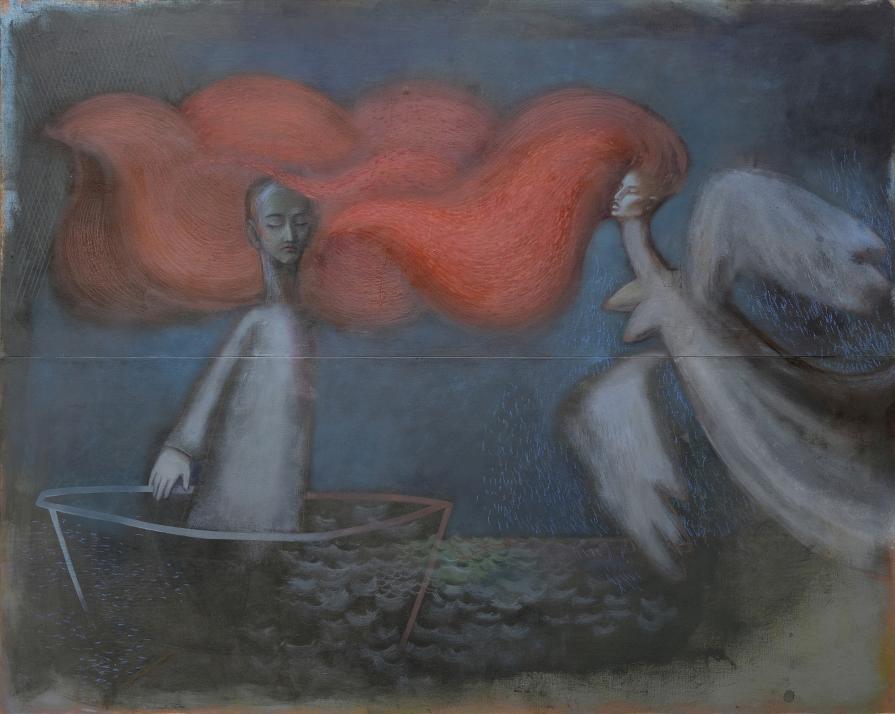Song of the Siren
Mixed Media on plywood board
Dimensions: 105 x 132 cm
- Alternative title of the painting: "Deaf as Odysseus to the Siren's Song"
Greek Mythology and the saga of Odysseus, in particular, have offered endless inspiration to artists and writers throughout time. In the infamous "Comedy of Errors" by William Shakespeare, Antipholus of Syracuse finds himself attracted to Luciana, who unbeknownst to him is the sister of his twin brother's wife Adriana. By the end of the scene, however, he is so thoughtfully baffled by the behavior of that enchantress, the 'siren' as she calls her, that he vows:
"I'll stop my ears against the mermaid's song."
Similarly, in Venus and Adonis, Adonis protests against his lover's seductive rhetoric, "bewitching like the wanton mermaid's songs," and manfully declares:
My heart stands armed in my car, and will not let a false sound enter there.
In both cases, Shakespeare alludes to Odysseus's encounter with the Sirens, in the XII book of Homer's Odyssey. The deeper message of "The Comedy of Errors" is to remind people that intuitive identifications can spell trouble. In the aforementioned verses, the unspoken referent is not so much the crew as the Greek hero himself. Odysseus's encounter with the Sirens in Homer's Odyssey remains one of the best-known episodes in world literature.
In Homer's Odyssey, the Greek hero Odysseus, advised by the sorceress Circe, escapes the danger of the Sirens' song by stopping the ears of his crew with beeswax so that they are practically deaf. Odysseus himself wants to hear their song and has himself tied to the mast of his ship so that he is unable to steer it off its course.
In art, the Sirens first appeared as birds with the heads of women and later as women, sometimes winged, with bird legs.
This particular poem and the episode of Odysseus's adventures offered a tingling inspiration to Agnese. The Odyssey (written in the 8th century BC) is one of two major ancient Greek epic poems in 24 books traditionally attributed to the ancient Greek poet Homer. The poem is the story of Odysseus, the king of Ithaca, who wanders in the sea for 10 years trying to get home after the Trojan War.
Agnese came up with the concept and initial sketches of the "Song of the Siren" following her visit to Sicily in late 2020. In Agnese's own words:
“My work obtains a meaning when an exploratory or investigative process is involved. Otherwise, it feels just like a mechanical process. This has also been the case with "The Siren's Song". Following my recent trip to Sicily where I visited a good number of Ancient Temples, Archeological Museums, and the spectacular Ancient Greek Theatre of Taormina, I was fascinated by the story of Odysseus and started searching the Odyssey further for deeper, well-hidden messages and meanings. The Sirens try to lure Odysseus by a promise of knowledge: the history of the Trojan War, and everything that happens on the fruitful earth. But Odysseus never hears what the Sirens had to tell him; the gods still kept truth and knowledge hidden from mortals until the moment of their death. And the question remains the same: how can I best tell a story that is so essential to telling? Our stories narrate the way we portray and position ourselves in relationships to others, to our surroundings, but also, to ourselves. I believe that my painting communicates this eternal human quest for more knowledge and finally the truth. It's also that perfect imbalance between male and female, as Odysseus is a man and the Siren is a woman. It might be that the Siren knows the truth, but despite his genuine effort, Ullyseus never finds out. Seen from a rather different and wider perspective my painting attempts to speak this unspoken truth...“
The painting "The Song of the Siren" comes as one more piece in Agnese's genuine technique of working with mixed media (oil, acrylic, and oil pastel) on plywood board, and resonates the religious themes of her recent paintings such as "The Shape of Soul" (Dvēseles forma) of 2016 and "Noah's Ark" (Noasa škirsts, 2016). In these paintings, her ever-evolving style has been influenced by the Novgorodian icon-painting school and loosely relates to iconography. Her discrete iconic manner and constant play with characters and motifs balance between religious painting and stage design and sparks different interpretations.
When it comes to her choice of media used in her paintings, Agnese said:
"I am not sure I would ever try to stick with just one. I always challenge myself constantly as an artist, and try new things and grow by exploring and experimenting. It feels like an ongoing dialogue between the painting and me. Sometimes I get the impression that my artwork is asking for a different medium to be used; this also allows me to create different textures and instill life into my work. I enjoy watching the figures trying to literally jump out of the painting!"
Note: Odysseus is also known as Ulysses in English.












Commenti 0
Inserisci commento